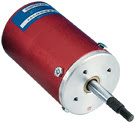 |
| Diaphragm Air Cylinder Courtesy ControlAir, Inc. |
Air cylinders convert air pressure into linear motion using a piston sealed to the inner walls of the cylinder. The introduction of sufficient air pressure into the cylinder forces the piston to move, driving a shaft that is connected to process equipment or devices. A single acting air cylinder is provided with a mechanical means of delivering an opposing force to the motion caused by increasing air pressure. Often a spring, this mechanical force will move the piston in the direction opposite that of increasing air pressure. As the air pressure is reduced, the piston will move toward its normal, or default, position.
A double acting air cylinder enables the introduction of air pressure on either side of the piston, providing air powered movement in both directions. In this design, a loss of air pressure will result in the load driving the piston to a default position, but also provides some flexibility in operation not inherent in the spring return single action design.
The method used to create a seal between the piston and the cylinder wall impacts the operation and longevity of an air cylinder. A seal affixed to the piston that will slide along the cylinder wall as the piston is driven to each new position encumbers operation with friction and stiction. Friction will cause wear on the seal material, with its deterioration eventually impacting response of the cylinder to a control signal. Stiction, also called "static friction" or "stationary friction" refers to the resistance to relative motion of two bodies in contact with one another. In practice, we see stiction as the reason why it often takes more force to get the piston moving than it does to keep it in motion. This also causes inaccuracy in linear positioning of the load.
ControlAir overcomes both drawbacks with their Rolling Diaphragm Air Cylinders. Instead of a fixed seal between the piston and cylinder wall, a flexible diaphragm connects to the leading edge of the piston and the end of the cylinder. The piston diameter is sufficiently less than that of the cylinder, providing space for the diaphragm to roll up as the piston changes position. The design delivers negligible levels of resistance to piston movement, with resulting superior positioning capabilities.
The datasheet provided below has more detail and cutaway illustrations of both single and double acting versions, so you can see how the diaphragm concept functions. Share your linear motion and automation challenges with process control experts, combining your own experience and knowledge with their expertise to develop the most effective solutions.